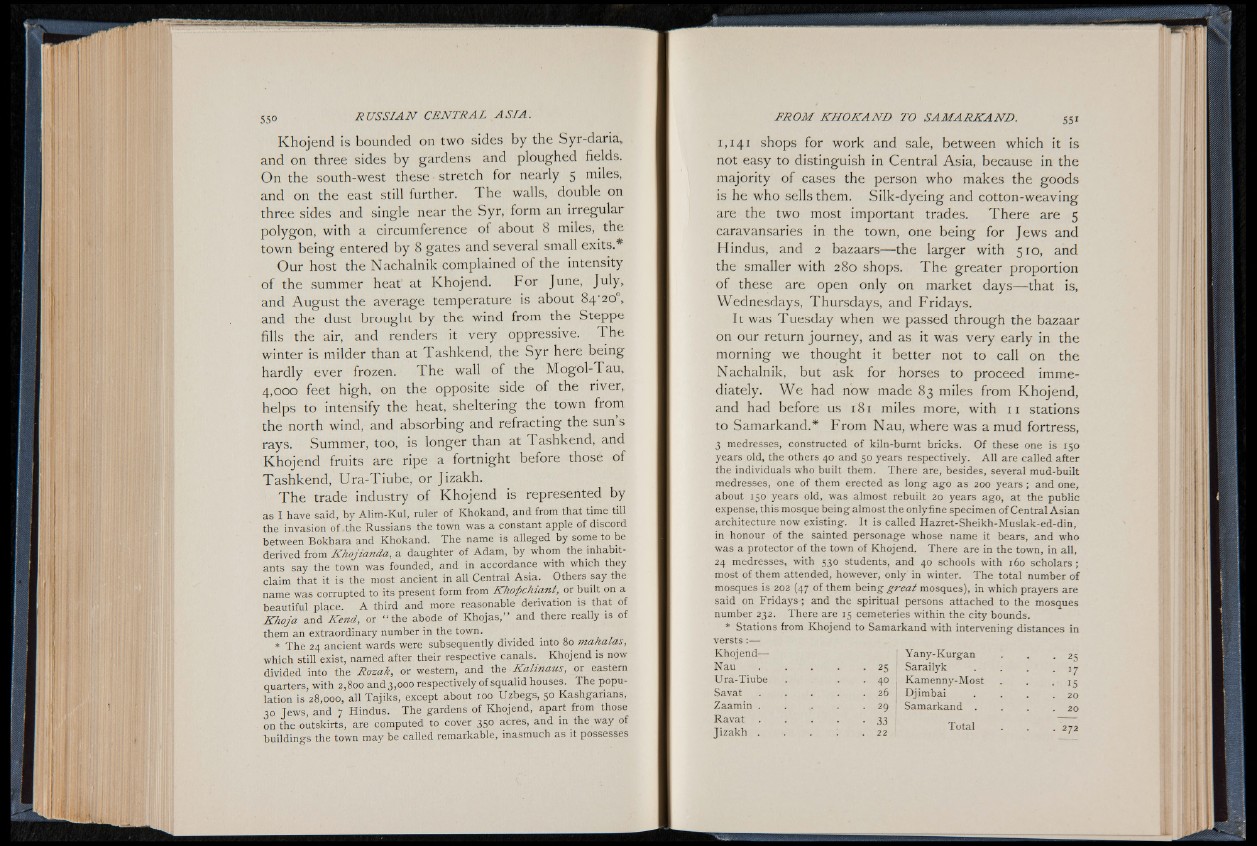
Khojend is bounded on two sides by the Syr-daria,
and on three sides by gardens and ploughed fields.
On the south-west these stretch for nearly 5 m^es>
and on the east still further. The walls, double on
three sides and single near the Syr, form an irregular
polygon, with a circumference of about 8 miles, the
town being entered by 8 gates and several small exits.*
Our host the Nachalnik complained of the intensity
of the summer heat' at Khojend. For June, July,
and August the average temperature is about 84/20,
and the dust brought by the wind from the Steppe
fills the air, and renders it very oppressive. T he
winter is milder than at Tashkend, the Syr here being
hardly ever frozen. The wall of the Mogol-Tau,
4,000 feet high, on the opposite side of the river,
helps to intensify the heat, sheltering the town from
the north wind, and absorbing and refracting the sun s
rays. Summer, too, is longer than at Tashkend, and
Khojend fruits are ripe a fortnight before those of
Tashkend, Ura-Tiube, or Jizakh.
The trade industry of Khojend is represented by
as I have said, by Alim-Kul, ruler of Khokand, and from that time till
the invasion of the Russians the town was a constant apple of discord
between Bokhara and Khokand. The name is alleged by some to be
derived from Khojianda, a daughter of Adam, by whom the inhabitants
say the town was founded, and in accordance with which they
claim that it is the most ancient in all Central Asia. Others say the
name was corrupted to its present form from Kho'pchiant, or built on a
beautiful place. A third and more reasonable derivation is that of
Khoja and Kend, or “ the abode of Khojas,” and there really is of
them an extraordinary number in the town.
* The 24 ancient wards were subsequently divided into 80 mahalas,
which still exist, named after their respective canals. Khojend is now
divided into the Rozak, or western, and the Kalinaus, or eastern
quarters, with 2,800 and3,ooo respectively o f squalid houses. The population
is 28,000, all Tajiks, except about 100 Uzbegs, 50 Kashgarians,
30 Jews, and 7 Hindus. The gardens of Khojend, apart from those
on the outskirts, are computed to cover 350 acres, and in the way of
buildings the town may be called remarkable, inasmuch as it possesses
1,141 shops for work and sale, between which it is
not easy to distinguish in Central Asia, because in the
majority of cases the person who makes the goods
is he who sells them. Silk-dyeing and cotton-weaving
are the two most important trades. There are 5
caravansaries in the town, one being for Jews and
Hindus, and 2 bazaars— the larger with 510, and
the smaller with 280 shops. The greater proportion
of these are open only on market days— that is,
Wednesdays, Thursdays, and Fridays.
It was Tuesday when we passed through the bazaar
on our return journey, and as it was very early in the
morning we thought it better not to call on the
Nachalnik, but ask for horses to proceed immediately.
W e had now made 83 miles from Khojend,
and had before us 181 miles more, with 11 stations
to Samarkand.* From Nau, where was a mud fortress,
3 medreSses, constructed o f kiln-burnt bricks. Of these one is 150
years old, the others 40 and 50 years respectively. A ll are called after
the individuals who built them. There are, besides, several mud-built
medresses, one of them erected as long ago as 200 y e a r s ; and one,
about 150 years old, was almost rebuilt 20 years ago, at the public
expense, this mosque being almost the only fine specimen of Central Asian
architecture now existing. It is called Hazret-Sheikh-Muslak-ed-din,
in honour of the sainted personage whose name it bears, and who
was a protector of the town of Khojend. There are in the town, in all,
24 medresses, with 530 students, and 40 schools with 160 scholars ;
most of them attended, however, only in winter. The total number of
mosques is 202 (47 of them being great mosques), in which prayers are
said on Fridays ; and the spiritual persons attached to the mosques
number 232. There are 15 cemeteries within the city bounds.
* Stations from Khojend to Samarkand with intervening distances in
v e r s ts :—
Khojend— Yany- Kurgan • 25
Nau • 25 Sarailyk •
Ura-Tiube . 40 Kamenny-Most • !5
Savat . 26 Djimbai . 20
Zaamin . . 29 Samarkand . . 20
Ravat
• 33
Jizakh .
; . 22 Total . 272